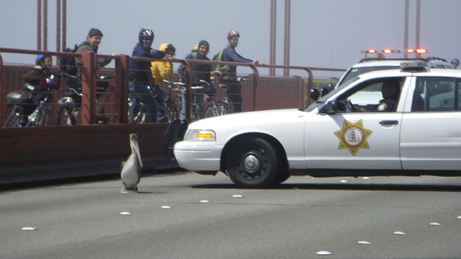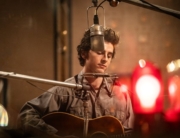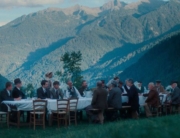A California brown pelican blocks traffic on the Golden Gate Bridge. Bystanders watch as bridge security capture it and place it in the back of a waiting police car. Someone jokingly comments, “Awww, he got arrested.” Not quite, but the pelican is headed for a prison of sorts.
At a wildlife hospital, filmmaker Judy Irving talks with the veterinarian, Monte Merrick, as he examines the bird. Merrick explains that, while there is no evidence of physical trauma, the pelican is extremely underweight and dehydrated. It is a female, only three or four months old. He starts her on an electrolyte solution in hopes that she’ll recover, and places her in a group of other recuperating pelicans in an aviary-like enclosure that features pools to swim in and room to fly. A temporary numbered band on her leg serves as her identity during her stay. Irving, however, decides to call her Gigi, an acronym for Golden Gate.
Irving goes on to describe the dreams she had as a child, in which she was flying, and her affinity for pelicans, whom she referred to in her youth as “flying dinosaurs.” She admits to knowing very little about them and sets out to discover as much as she can. She visits Santa Barbara Island to capture footage of mating pelicans and family interactions once the chicks are born, revealing the likely cause of Gigi’s malnourished condition. An interview with a charter boat captain sheds light on ways that sport fishermen’s lines, hooks, and large catches can be disastrous for opportunistic pelicans, highlighting just one of the many perils that threaten the birds’ survival.
Returning at intervals to check on Gigi’s condition, Irving also introduces a former hospital worker, Dani Nicholson, who has brought home three injured pelicans from the wildlife infirmary that require long-term care. Morro, Chorro and Torro all have broken wings. Chorro and Torro heal nicely and fly off as soon as they are able, but Morro’s wing will not heal, posing a dilemma for Dani and her husband who, by law, cannot keep him in captivity.
Punctuating the documentary are interludes of mellow music (by Bruce Kaphan) accompanying dream-like, slow-motion footage of the pelicans in their natural habitat, soaring and gliding gracefully in a diaphanous veil of mist before plummeting, arrow straight, into a crystal sea to feed. This imagery, coupled with the stories of Gigi and Morro, raise the underlying question of what it means to be “wild and free” in a world where human intervention, for good or ill, is unavoidable. Wisely, Irving allows the viewer to ponder this dilemma without moralizing, instead leading her audience to see the commonalities that exist between humans and pelicans. Her “flying dinosaurs” emerge as fellow beings.
In a director’s statement, Irving says that her aim is to “engage viewers in a story that will change the way they see and relate to nature.” While the educational content and separate accounts of the two injured pelicans don’t always flow into a cohesive storyline, Irving nevertheless achieves her goal of providing her viewers with a deeper comprehension of the natural world of which we are just one small, but influential, part.







Leave A Comment